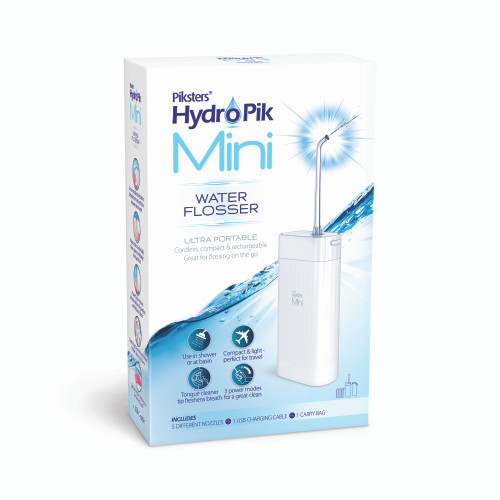This is Piksters larger capacity HydroPik Pro - bigger reservoir to give you more durable water supply.
- Enables the user to use it twice without filling it again (on low power) or to use it at a higher pressure and high flow rate (for higher cleaning power) than with smaller units.
- Maximum power: 110 P.S.I.* (Compares to other brands at 70 p.s.i.)
Oral irrigator removes 99.9% of plaque* and is a more effective alternative to traditional dental floss for reducing gingival bleeding and improving oral health.**
- Nozzle case for tip storage.
- High volume 600ml water tank.
- Nozzle can be easily released by pressing the button.
- Water flow On/Off switch.
- Safe 12V wall power supply.
- On/Off control. Rotate switch to adjust water pressure with 10 settings.
- 3 standard tips + bonus tongue cleaner.
- Nozzle turn 360O for easy cleaning of all areas of your mouth.
- Magnet holds handle in place.
- 1 metre extension water pipe.
For clinical evidence confirming water flossing effectiveness, see these articles from peer reviewed dental journals–
1. *Oral irrigator removes 99.9% of plaque.
Gorur A et al. Biofilm removal with a dental water jet. Compend Contin Ed Dent 2009; 30 (Suppl 1):1 - 6.
2. **Oral irrigator is a more effective alternative to traditional dental floss for reducing gingival bleeding and improving oral health.
Rosema NAM et al. The effect of different interdental cleaning devices on gingival bleeding. J Int Acad Periodontol 2011; 13(1):2-10.
3. Oral irrigator and brushing up to 3X as effective for removing plaque around braces vs. string floss.
Sharma NC et al. The Effect of a Dental Water Jet with Orthodontic Tip on Plaque and Bleeding in Adolescent Orthodontic Patients with Fixed Appliances.
Am J Ortho Dentofacial Orthop 2008; 133(4):565-571.
4. Up to 2X as effective for improving gum health around implants vs. string floss.
Magnuson B et al. Comparison of the Effect of Two Interdental Cleaning Devices Around Implants on the Reduction of Bleeding: a 30-day Randomized Clinical Trial. Compend of Contin Ed in Dent 2013; 34 (Special Issue 8):2-7.














